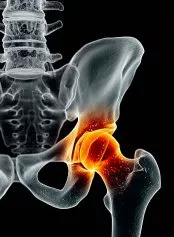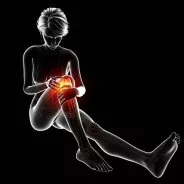
ENTHESOPATHY OF HIP & KNEE
Hip and knee enthesopathy is usually linked to overuse or stress put on your child’s limbs. This type of enthesopathy often results from conditions such as patellar tendonitis. Patellar tendonitis is also called a runner’s knee.
If your child needs surgery or casting, our Fracture Care Clinic opens every day and you do not need an appointment. Surgery rooms get scheduled every morning, so your child receives the care and attention they need right away.
Enthesopathy of Hip & Knee

 Enthesopathy is a problem related to the attachment of tendons, ligaments, or parts of a joint onto the bone. It is a medical term that refers to the inflammation of one or more entheses. Entheses are the sites at which ligaments and tendons attach to bones. People with enthesopathy generally experience pain and may have stiffness or difficulty moving the affected joint or area of the body. And if you are wondering whether or not enthesopathy or enthesitis are the same, here is the answer. When an inflammatory condition, for example, rheumatoid arthritis, generates the pain of enthesopathy, it is enthesitis.
Enthesopathy is a problem related to the attachment of tendons, ligaments, or parts of a joint onto the bone. It is a medical term that refers to the inflammation of one or more entheses. Entheses are the sites at which ligaments and tendons attach to bones. People with enthesopathy generally experience pain and may have stiffness or difficulty moving the affected joint or area of the body. And if you are wondering whether or not enthesopathy or enthesitis are the same, here is the answer. When an inflammatory condition, for example, rheumatoid arthritis, generates the pain of enthesopathy, it is enthesitis.
The symptoms of enthesitis are quite similar to those of enthesopathy. And it can feel like normal joint pain or pain near the joint. A person with enthesopathy in the Achilles tendon will experience worsening pain when walking or running. When enthesopathy is related to other conditions such as rheumatoid arthritis, treating the underlying reason can help. Physical therapy and lifestyle remedies can also help treat the condition.
Cause
Common reasons for enthesopathy include:
- Overuse – Especially from repetitive movements, for example, playing tennis or running.
- Trauma – A fall or a direct blow to an area, or micro-injury to an area.
- Autoimmune diseases – Rheumatoid arthritis or any other inflammatory conditions.
- Genetics – Sometimes, certain genes make a person more susceptible to certain injuries.
Enthesopathy may develop at any joint or area where tendons or ligaments connect. And it may generate pain near different joints. The hips, fingers, heel, knees, toes, elbows, and backbone are common sites for developing enthesopathy.
QUESTIONS AND ANSWERS
What is enthesopathy of the hip and knee in children, and what causes it?
Enthesopathy of the hip and knee in children refers to the inflammation or irritation of the entheses (tendon or ligament attachment points) in these specific areas. It can occur due to various reasons, including repetitive stress or overuse of the tendons or ligaments around the hip and knee joints. This can be a result of physical activities, sports participation, growth spurts, or certain medical conditions. Trauma or injury to the hip or knee can also contribute to the development of enthesopathy.
What are the common symptoms and signs of enthesopathy of the hip and knee in children?
Children with enthesopathy of the hip and knee may experience symptoms such as pain, tenderness, stiffness, swelling, and reduced range of motion around the affected joints. Pain and discomfort typically worsen with movement, particularly during activities that stress the tendons or ligaments in the hip and knee. These symptoms may affect the child’s ability to participate in sports, physical activities, or daily routines.
How is enthesopathy of the hip and knee diagnosed and treated in children?
Diagnosis of enthesopathy of the hip and knee involves a thorough medical history, physical examination, and possibly imaging studies such as X-rays or MRI to assess the affected areas. The treatment typically includes a combination of rest, ice, anti-inflammatory medications, and physical therapy to reduce pain, inflammation, and improve strength and flexibility. Activity modification is often advised to avoid exacerbating the condition. In severe or persistent cases, a healthcare professional may recommend corticosteroid injections or other specific treatments.
Healing a Child’s body from sports injuries takes expertise and the doctors at Medical City Children’s Orthopedics and Spine Specialists have the Knowledge, Skills, and Abilities to properly heal Children.
Enthesopathy of Hip and Knee Symptoms
Enthesopathy is a condition that affects the points where tendons, ligaments, and muscles attach to bones, causing pain and inflammation. The symptoms can vary depending on the location of the affected joint and the underlying cause of the condition. Some common symptoms of enthesopathy include:
- Pain: The most common symptom is pain, which can be severe and constant, or it can come and go. The pain is often worse when your child use the affected joint.
- Stiffness: The affected joint may feel stiff and difficult to move, especially in the morning or after sitting for a long time.
- Swelling: Swelling in the affected joint can occur if the enthesopathy affects the feet or legs.
- Warmth: The affected joint may feel warm to the touch due to increased blood flow and inflammation.
- Tenderness: The area around the affected joint may be tender to the touch.
- Weakness: The affected joint may feel weak, making it difficult to use the joint normally.
- Limited Range of Motion: The affected joint may have a limited range of motion, making it difficult to move the joint through its full range of motion.
It’s important to note that the symptoms of enthesopathy may resemble other conditions or medical problems. So it’s important to consult a doctor for proper diagnosis and treatment.
Enthesopathy of The Hip
Conditions like spondyloarthritis can generate pain in your child’s hip bones. Also, they can lead to general lower back pain. People and children with this condition may also find it hard to move their spine. It is because spondyloarthritis can cause your vertebrae to join together. Plus, hip enthesopathy can sometimes appear with bowel conditions, such as inflammatory bowel disease, or with a gene passed down in families.
Enthesopathy of The Knee
Knee enthesopathy generally associated with overuse or stress on your child’s knees. This type of enthesopathy is often the result of conditions such as patellar tendonitis aka runner’s knee.
In this condition, the pain usually worsens especially when your child is exercising and putting more stress on the knees. Also, your child may experience pain while performing certain daily tasks, including standing up from a sitting position or going upstairs.
Diagnosis
Enthesopathy is a condition that affects the points where tendons, ligaments, and muscles attach to bones, causing pain and inflammation. The diagnosis of enthesopathy is typically made through a combination of a physical examination, a review of the symptoms, and additional tests.
- Physical examination: The doctor will examine the affected joint and may apply pressure to the area to check for pain, tenderness, and warmth. They may also check for any signs of swelling or redness and will assess the range of motion of the affected joint.
- Review of symptoms: The doctor will ask about the patient’s symptoms, including how long they have been experiencing them and how severe they are. They will also ask about any other medical conditions or medications the patient takes, as these can affect the diagnosis.
- Additional tests: Depending on the location and severity of the symptoms, the doctor may recommend additional tests to help with the diagnosis and to rule out other conditions.
These tests may include the following:
- Joint fluEnthesopathy can often be managed with a combination of medication, treatment, and lifestyle changes. In some cases, the condition can resolve completely, particularly if it is the result of overuse, stress, or trauma. Sometimes the enthesopathy is caused by an underlying immune system condition, such as psoriatic arthritis. In such cases, the doctor may remove a small sample of fluid from the affected joint and test it for signs of inflammation or infection.
- Urinalysis: A test that checks the urine for signs of infection or other underlying conditions
- Blood tests: Blood tests can check for signs of inflammation, infection, or other underlying conditions.
- X-rays: X-rays can help the doctor see the affected joint and check for any bone changes that may be related to enthesopathy.
It’s important to note that Enthesopathy can be caused by various underlying conditions. The doctor may need to conduct more tests to rule out those conditions and to determine the proper treatment.
Enthesopathy of Hip & Knee Treatment
People suffering from enthesopathy may get better with the help of various arthritis medications and other treatments including non-steroidal anti-inflammatory drugs (NSAIDs). There might be biologics in case the symptoms are associated with an autoimmune condition, corticosteroids, or other medications that will help manage the discomfort.
Physical Therapy
Physical therapy can play an effective role in relieving pain and reducing stiffness in the joints and surrounding areas. In most cases, physical therapy focuses on strengthening and loosening tense muscles. It also improves flexibility near the enthesis. Performing these exercises on both sides can prevent problems regarding posture, muscle imbalances, and worsening pain. Physical therapy can help individuals suffering from enthesopathy work around their injuries without worsening the pain.
Orthotics
Orthotic devices including heel cup shoe inserts effectively help reduce the pain of certain types of enthesopathy. And these may also prevent further injury. A splint helps support the joint and stretch the surrounding muscles, especially at night.
Lifestyle changes
To manage enthesopathy, individuals may need to avoid exercises that put stress on affected joints, such as running or weight-bearing exercises. Instead, non-weight-bearing activities like biking, swimming, and rowing may be beneficial. Additionally, treatments such as cold or hot packs, massaging the affected joint or surrounding muscles, cold laser therapy, and alternative therapies like acupuncture may help reduce inflammation and pain. Corticosteroid injections may also be used for inflammatory enthesitis. It’s important to avoid movements that cause pain.
Enthesopathy of Hip & Knee Outlook
Enthesopathy can often be managed with a combination of medication, treatment, and lifestyle changes. In some cases, the condition can resolve completely, particularly if it is the result of overuse, stress, or trauma. Sometimes the enthesopathy is caused by an underlying immune system condition, such as psoriatic arthritis. In such cases, the doctor will develop a treatment plan to manage the symptoms and address the underlying cause.
While it may be possible to relieve short-term discomfort caused by symptoms, a long-term plan is necessary to prevent the condition from worsening and causing further damage to the entheses and the joint. Our doctors will tailor the treatment plan to the individual. It may include a combination of medications, physical therapy, and lifestyle changes.
Conclusion:
Finally, bone healing in children is a dynamic process that is typically faster and more efficient compared to adults. By understanding the stages of bone healing and providing proper nutritional support, parents can facilitate and enhance the healing process. The Medical City Children’s Orthopedics and Spine Specialists has offices in Arlington, Dallas, Flower Mound, Frisco, and McKinney, TX, and specializes in Children. As specialists, Doctors Richard Hostin, MD, Shyam Kishan, MD, and Kathryn Wiesman, MD treat children for minor and major medical problems. We invite new patients to call and make an appointment. We will see your child quickly and find a solution to get your child back to being the kid he or she is.
____________________
Footnote:
Call 214-556-0590 to make an appointment.
Comprehensive services for children from birth through adolescence at five convenient locations: Arlington, Dallas, Flower Mound, Frisco and McKinney.
